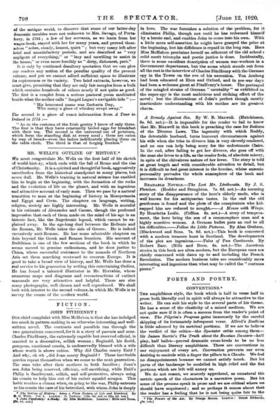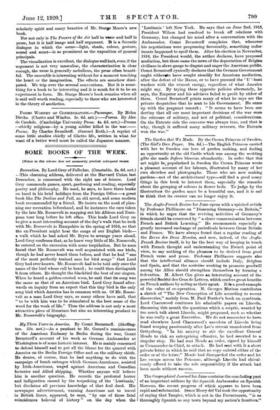POETS AND POETRY.
CONVENTIONS.*
Dam amphibious style, the book which is half in verse half in prose both literally and in spirit will always be attractive to the writer. He can suit his style to the several parts of his theme. He has a sense of the elasticity of a mixed medium. We are not quite ease if it is often a mimosa from the reader's point of view. The Pilgrim's Progress gains immensely by the careful skipping of its fortunately infrequent verse. Alfred's Boethius is little adorned by its metrical portions. If we are to believe the verdict of the critics—the Spectator critic among them— Sir James Barrie's The Truth about the Russian Dancers—half play, half ballet—proved dramatic cross-breds to be no less difficult than literary amphibians. There are conventions in our enjoyment of every art. Convention prevents our even desiring to encircle with a. finger the pillars in a Claude. We feel no disappointment because we cannot satisfy touch. But let parts of the landscape be modelled in high relief and the flat portions which are left will annoy us.
We do not resent, we scarcely apprehend, as unnatural the metric speech of the characters in a narrative poem. But let some of the persona speak in prose and we are critic'sl where we should have acquiesced ; and so perhaps it comes about that the reader has a feeling that he is not being quite fair to the
• Tho POILVITI of the Air. By Sturge Moors. London : Grant Richards. ea. net.]
scholarly spirit and many beauties of Mr. Sturge Moore's new book.
For not only is The Powers of the Air half in verse and half in prom, but it is half image and half argument. It is a Socratic dialogue in which the scene—light, shade, colour, gesture, sound and scent—is as prominent as the exposition of general principals.
The -visualization is excellent, the dialogue well knit, even if the -argument is not very masculine, the characterization is clear enough, the verse is generally melodious, the prose often beauti- ful. The ensemble is interesting without for a moment touching the heart or the imagination. The effects are somehow dissi- pated. We trip over the several conventions. But it is some- thing for a book to be interesting and it is much for it to be an experiment in form. Mr. Sturge Moore's book remains when all is said well worth reading, especially to those who are Interested in the theory of aesthetics.







































 Previous page
Previous page